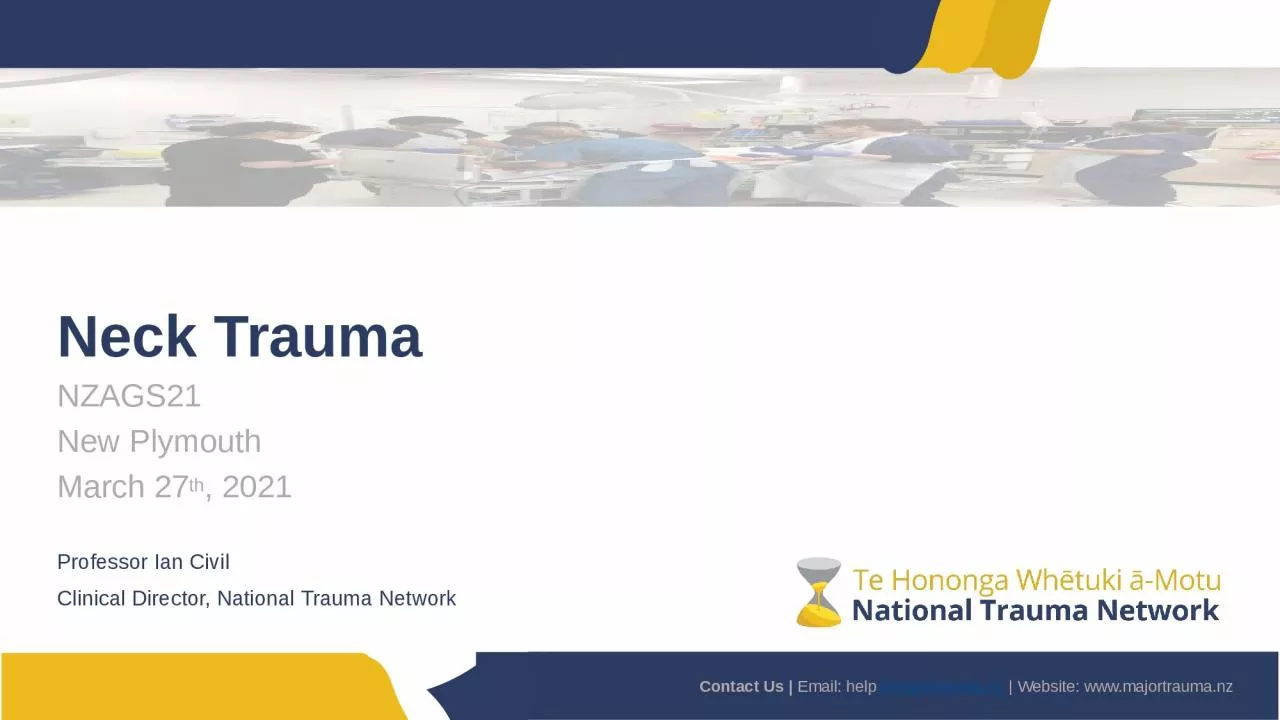

March 27 th 2021 Professor Ian Civil Clinical Director National Trauma Network Challenging neck trauma Blunt versus penetrating Blunt trauma to the neck commonly reflects potential for spinal injury an ortho issue which is not part of this presentation ID: 933290
Download Presentation The PPT/PDF document "Neck Trauma NZAGS21 New Plymouth" is the property of its rightful owner. Permission is granted to download and print the materials on this web site for personal, non-commercial use only, and to display it on your personal computer provided you do not modify the materials and that you retain all copyright notices contained in the materials. By downloading content from our website, you accept the terms of this agreement.
Slide1
Neck Trauma
NZAGS21New PlymouthMarch 27th, 2021
Professor Ian Civil
Clinical Director, National Trauma Network
Slide2Challenging neck trauma….
Slide3Blunt versus penetrating
Blunt trauma to the neck commonly reflects potential for spinal injury – an ortho issue which is not part of this presentation
Blunt trauma may cause visceral or vascular injury – seldom immediately life threatening
May be immediately life threating if airway involved or critical haemorrhage occurs
Penetrating trauma may involve visceral or vascular structures
Slide4Penetrating neck trauma
Slide5Penetrating neck trauma
What are the issues here?Where are the potential injuries?
What would be required to treat them?
Slide6Zones….
Slide7Who came up with the idea of zones?
Slide8Who came up with the idea of zones?
Slide9Slide10Further, we propose a ‘‘No Zone’’ approach to imaging triage for these patients using multidetector CTA (Fig. 1) as a safe and very effective modality for the initial evaluation, trajectory determination, injury identification, and subsequent decision-making in patients presenting with penetrating neck trauma.
The American Surgeon; Atlanta
Vol. 79,
Iss
. 1, (Jan 2013): 23-9
.
Slide11J Trauma Acute Care Surg. 2020;89: 1233–1238
Slide12This is the first systematic review to examine the role of CTA in PNT.
In combination with physical examination, CTA demonstrated a reliable high sensitivity and specificity for detecting injuries in PNT in stable patients with soft signs of injury and select patients with hard signs of injury.
Unstable patients with hard signs should always undergo immediate neck exploration.
The results of this review support the management of PNT using no-zone approach based on physical examination and the use of CTA in stable patients
Slide13Diagnostic accuracy of CTA
Sensitivity 85-100%Specificity 95-100%PPV 85-100%NPV 98-100%
Slide14Accepted for publication 5 January 2021.
doi: 10.1111/ans.16600
Slide15This systematic review provides level 2A evidence that the ‘no zone’ approach to PNI management through the use of highly sensitive and specific CT-A imaging coupled with thorough clinical examination is a safe algorithm, which reduces rates of negative neck exploration.
Clinical assessment remains important for stratification of patients into hard, soft and asymptomatic groups, with some allowance for clinician discretion with regards to haemodynamically stable patients with hard signs, and asymptomatic patients with a high impact mechanism or concerning features.
Slide16But who is safe to have a CTA?
Patients with soft signsStable patients with hard signs SO…..What are hard and soft signs?
Hard signs
Pulsative haemorrhage
Expanding haematoma
Bruit/thrill
Absent pulses
Extremity ABI<0.9
Soft signs
History of haemorrhage
Wounds and unexplained haemorrhagic shock
Neurologic deficit
High risk
fx
, dislocation or proximity wound
Slide17Hard signs versus soft signs
Slide18In the era of readily available CT imaging, using hard and soft signs as a decision-making strategy is outdated
These signs do not provide a useful clinical distinction and a strategy of using haemorrhagic and ischaemic signs of vascular injury is of far greater utility
(J Trauma Acute Care Surg. 2021;90: 1–10)
Slide19Haemorrhagic and Ischaemic signs
Haemorrhagic signsHemorrhageExpanding hematomaTHESE PATIENTS NEED TO GO TO THE OR
Ischaemic
signs
Absent or diminished pulses
Neurologic deficit
THESE PATIENTS CAN HAVE CT
Hard signs
Pulsative haemorrhage
Expanding haematoma
Bruit/thrill
Absent pulses
Extremity ABI<0.9
Slide20Blunt neck trauma
Apart from cervical spine injuries the potential is forBCVILaryngeal injuryPharyngeal injuryOesophageal injury
Slide21The new Denver Health Medical Center
BCVI screening guideline.Risk Factors for BCVIHigh energy transfer mechanism associated with:Displaced mid-face fracture (
LeFort
II or III)
Mandible fracture
Complex skull fracture/basilar skull fracture/occipital condyle fracture
CHI consistent with DAI and
GCS < 6
Cervical subluxation or ligamentous injury, transverse foramen fracture, any body fracture, any fracture C1-3
Near hanging with anoxic brain injury
Clothesline type injury or seat belt abrasion with significant swelling, pain, or altered MS
TBI with thoracic injuries
Scalp degloving
Thoracic vascular injuries
Blunt cardiac rupture
Slide22(J Trauma Acute Care Surg. 2020;88: 875–887)
Slide23Screening or not for detection of BCVI?
With no screening protocol 0.2%, with screening protocol 0.7% OR 4.74
Note old studies. Current accepted incidence with effective screening 1.6-2%
Slide24Antithrombotic therapy or not to prevent stroke?
Strokes in 79/235 (33.6%) vs 70/713 (9.8%) RR 0.2
Slide25Recommendations
Slide26Laryngeal trauma
Has the patient got an airway problem?
Have they got a hoarse voice?
Even if initially normal, problems may develop over 24hrs
Slide27Laryngoscope
, 124:233–244, 2014
Slide28Slide29Slide30Pharyngeal and oesophageal trauma
Blunt pharyngeal or oesophageal injuryPenetrating pharyngeal or oesophageal trauma
Usually iatrogenic
Follow the trajectory
Other injuries usually determine approach
Repair and drain
Slide31